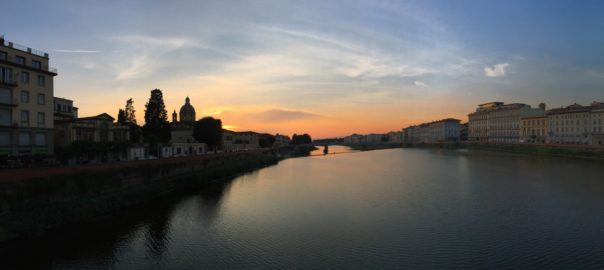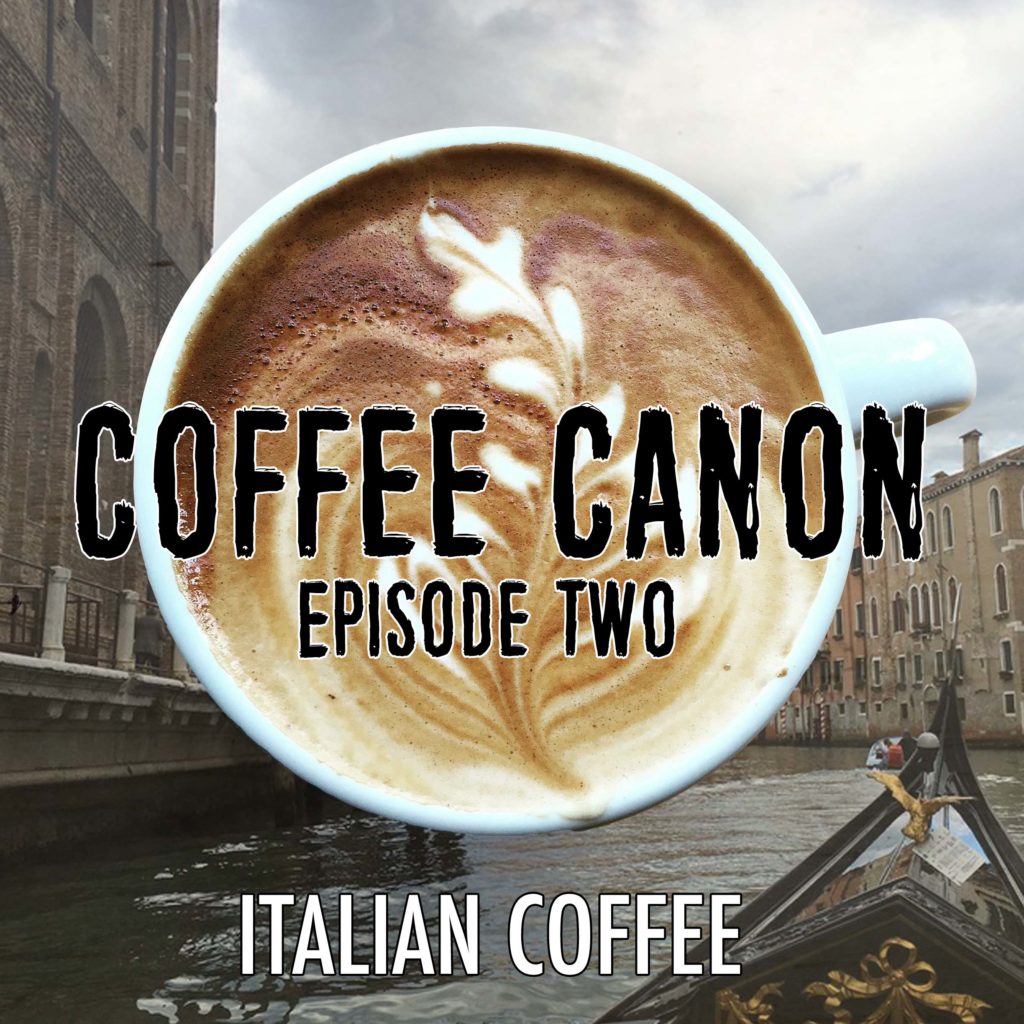Episode Two of Coffee Canon focuses on Italian coffee. We often associate Italy with espresso, but the truth is that true espresso didn’t exist until about 1950. Developing It took the work of key inventors, businesspeople, and visionaries who saw coffee not for what it currently was, but for what it could be.
In this episode I feature a radio interview by Professor Jonathan Morris. You can listen to the whole thing here. Also, he wrote a fascinating paper on Italy’s coffee journey: check it out here.
Enjoy the episode, and feel free to reference the sources below if you’d like to read more. Also, don’t forget to sign up for the Coffee Canon email list if you haven’t already.
Colin
Episode Two Sources:
- ‘A History of Espresso in Italy and in the World’ by Jonathan Morris. The primary source for this episode: http://www.academia.edu/262226/A_History_of_Espresso_in_Italy_and_in_the_World_2008_
- Jonathan Morris and Laurie Taylor radio interview: http://www.bbc.co.uk/programmes/b007tz8v
- How transatlantic exchange shaped Italy’s coffee culture: https://qz.com/992879/the-curious-tale-of-how-italy-became-the-world-capital-of-coffee/
- Wikipedia, History of the Moka Pot: https://en.wikipedia.org/wiki/Moka_pot
- ‘The Romance of Coffee and Aluminum’ by JT Schnapp, a great source for more on the Moka pot and Italian culture: http://earlymodernconversions.com/wp-content/uploads/2016/03/Schnapp-The-Romance-of-Coffee-and-Aluminum.pdf
- Music
- “Una Cosa” by Podington Bear – FreeMusicArchive.org
- “Blues Angeline” by Lobo Loco – FreeMusicArchive.org
Episode Two Transcript:
Everything has an inventor. This is sort of an obvious statement on its face – the fact that crafted things – manufactured things – really everything from modern conveniences to primitive technology has a person or a team behind they’re invention – we know this.
But how often do we actually stop and think about these people? There’s the big names, sure, like Steve Jobs, Henry Ford, Thomas Edison, Orville and Wilbur Wright, Elon Musk – people who have famously taken huge risks with their companies or ideas. Risks that worked out for them and shaped the world into what it is today.
But for every Thomas Edison there were 1,000 inventors and creators who’s names we’ve never heard. People who have shaped our world in just as powerful ways, but without the name ID.
Coffee is no different. Every single device and method used to harvest, process, roast, grind, and brew coffee beans has a person or group of people who pioneered that technique or invented that product. Last episode we talked briefly about the Hario v60 and how it reflects both Japanese culture and values. This week we’re going to discuss another country; a place that has its history deeply tied to coffee.
For half of the 20th century inventors, fortune-seekers, and businesspeople tried their hand at creating a machine that made coffee in less time, with better taste. The basic idea was that each customer could have an individual coffee brewed expressly for them, and quickly. The country is Italy and the device, of course, is the espresso machine.
I’m Colin Mansfield, and welcome to Coffee Canon.
I’ll confess that up until researching for this episode, in my head Italian coffee has always been espresso. The two are somehow synonymous to me: Italy and espresso. But the reality is that true espresso wasn’t even invented until about 1950. Venice was one of the first European ports to import coffee in the 1570s, and the first recorded coffee house didn’t open in Italy until 1683. This means that for about two and a half of the last three centuries, espresso didn’t even exist in Italian culture. It didn’t exist at all. In these early years Italian coffeehouse owners brewed coffee using infusion based methods that were popular across Europe at the time.
In 1901 everything changed. Luigi Bezzera, an inventor from Milan, patented a steam-powered coffee machine that forced hot water through a coffee cake at about 0.75 atmospheres of pressure. In 1903 Bezzera’s patent was acquired by a manufacturer named Desidero Pavoni who used it to produce the first commercial espresso machine in 1905. He called it the Ideale.
The concept of fresh made-to-order coffee is almost expected from coffee shops today, but in the early 1900s it was a novel concept. Being able to quickly and easily make individual cups of coffee for specific customers meant faster service and better drinks. This new espresso was marketed as a futuristic beverage – in one advertisement, an Italian artist used a steam locomotive to make a visual play on the idea of an express train.
These steam machines created a very different kind of espresso than we’re used to today: temperatures in the group head of the espresso machine rose to 250 degrees F and higher, causing the final drink to appear jet black and taste burnt. Crema – the thin, delicious layer of oil that sits at the top of a modern well-pulled shot of espresso, was never present in these old drinks. The pressure that these steam machines created was just too low, and the steam itself often contaminated the drinks as well. By modern standards, these first generation espresso machines created something closer to drip coffee than actual espresso. Still, the ball was rolling and the way Italians began to think about coffee was changing. In fact, these quick machines started something in Italian culture that remains to this day: standing cafe bars.
If you visit Italy today, there are two basic ways you can order coffee. The first way is to sit at a restaurant, order from a waiter, and be served your drink. This is fairly standard the world over, but the difference in Italy is that you actually end up paying more on your check for table service from he wait staff. The more affordable way to get your espresso or cappuccino is to visit one of the many standing cafes that line the streets of urban Italian cities. Getting your coffee this way means you’ll pay much lower prices – usually one or two Euros – and you’ll find yourself leaning against the bar, brushing shoulders with locals while you sip.
These standing cafe bars came around at the same time the first generation steam-powered espresso machines were popularized. The large machines stood on the counters and would serve dozens of urban Italians that came by to socialize, conduct business, or just for a quick jolt. The interesting thing about these cafes is that they were originally called “American bars” because of the saloon-like layout of the cafe. There were no tables, just one long bar. The first American bar in Italy was Caffé Manaresi in Florence. It was nicknamed “Caffé dei Ritti” by locals – ritti means upright in Italian.
Between the new bars and new coffee machines, Italians were drinking coffee more. Both the consumption of coffee per capita and the number of new cafes increased slowly between 1900-1930 – though it was still mostly the upper and middle classes who could afford coffee. It was still seen as a luxury beverage by many, including the Fascist regime. That’s probably why Italy’s increasingly hostile leadership started taxing coffee imports during the 1930s. This, in turn, made consumption drop.
Nonetheless, the 1930s proved to be an important decade for the development of espresso. Coffee industry leaders knew that the current machines produced bad coffee, and they wanted to fix it. One of the main issues was the contamination and burning of coffee because of steam. Francesco Illy, founder of the Illy caffe and roastery, came up with a compressed air solution to this problem in 1935 that he dubbed the Illetta. Unfortunately, it never saw production. In 1938 two different Italian men – a Milanese engineer named Cremonese and a bar owner named Achille Gaggia, patented a piston solution that pushed water through coffee at higher pressures. But with demand for coffee low and import prices high, producing these machines was just not a viable or financially responsible solution. Then, WWII began and coffee was on the back burner, so to speak.
In 1947 espresso changed forever. Achille Gaggia registered a new patent that year for a lever operated piston incorporating gearing and a spring. This machine was dead-simple to operate by hand, and it’s main function was to take water directly from a boiler, and force it through a compressed cake of coffee. Using a piston meant more pressure – more than 9 times more than the first generation espresso machines. This bump in pressure resulted in a thin moussey layer of tasty coffee oils sitting on top of the extracted end-product. Today, this crema is the defining characteristic that sets espresso apart from all other coffee methods. But in late 1940s Italy, this brand-new take on coffee was seen as an entirely different beverage. It was renamed caffe crema or cream coffee, to distinguish it from the darker, less-tasty standard coffee everyone had grown used to. Sometimes its difficult to let go of the past, even when it tastes like a mixture of burnt rubber and charcoal.
This new take on espresso further drove a wedge between the two places Italians most commonly drank coffee: the home, and the bar. Back in 1933 an Italian inventor named Luigi De Ponti patented a stove-top coffee brewing device that used steam to force water through a valve, through a coffee puck, and up into a serving chamber. If this sounds familiar, it’s because espresso machines at the time worked in much the same way. So just take a second and imagine what this invention would mean for Italian households in the 1930s, 40s, and 50s: you could make coffee in your home with the exact same quality as the cafe down the road. The man who formed the manufacturing company that produced this coffee maker was named Alfonso Bialetti. He called the device the “Moka Express” and in the economic boom of the 1950s, it found its place in nearly every Italian home. This was thanks, in large part, to Alfonso Bialetti’s son Renato. Renato returned from the war in 1946 after spending several years in a German prisoner-of-war camp. Renato brought an entirely new sensibility to Bialetti’s Moka Express; he knew they had something special on their hands, and he focused a huge advertising budget on this fact. He started national campaigns, placing advertisements on billboards, in newspapers and magazines, on the radio, and once TV became widely available, there too. Renato’s focus was on building a strong brand around the distinctive coffee maker. One example of Renato’s intense focus on advertising is this: each year, Italy held a massive trade fare in Milan called the Fiera di Milano. Renato used this as an opportunity: year after year, the Bialetti company purchased every single billboard in the city Milan, plastering images of the Moka Express literally everywhere. Perhaps Renato’s largest contribution to the brand, however, was a distinctive mustachioed cartoon man with his right finger held aloft as if ordering an espresso. This logo still adorns every Moka Express manufactured by Bialetti.
So, here we are in the late 1940s early 1950s with two distinct approaches to coffee: on one hand, you have new engineering breakthroughs with espresso machines that allow cafes to produce truly great tasting coffee for the first time in history. On the other hand, you have Bialetti’s Moka Express that promises to bring the cafe into the kitchen, but with a more, well, traditional coffee taste. This difference in location and taste remains to today; about 90% of Italians have a personal Moka Express for at-home use, yet everyone still gets espresso from their local cafe.
In 1948 Gaggia released his first manufactured lever-driven espresso machines. With slogans like “Natural cream coffee” and “it works without steam,” it’s obvious that Gaggia knew that he had something special on his hands. And he was right – the market shifted at an alarming rate over the next 10 years. Milan proved to be the epicenter of change, with many of the ideas that shaped the future of coffee originating from Milanese people and companies. Updates to the Gaggia concept were rapid fire: the Cimbali company replaced the spring-loaded piston with hydraulic levers, making it easier to physically operate the machine. Pavoni, the same manufacturer who had acquired Luigi Bezzera’s original espresso machine patent way back in 1903, had the idea of turning the tall boiler on its side, creating a longer horizontal machine that allowed baristas to interact with customers. Ernesto Valente, who split from Gaggia in 1950, introduced an electric pump to his machine in 1961. It was operated by a simple switch – no need to pull any levers. To accomplish this, the machine pulled water directly from the water mains, pressurized it, and heated it before pushing it through the coffee puck. This meant that the barista only had to control the parameters associated with extracting coffee (grinding, time of extraction, etc) but didn’t have to provide the physical power for the process. This type of machine was dubbed “semi-automatic” and became the standard tool for cafes not only in Italy, but all across the world in years to come.
An interesting note about coffee in Italy – not every region has the same tastes. Broadly speaking, southern Italy prefers espresso blends with higher quantities of Robusta beans – the cheaper, bitter alternative to Arabica beans that are standard today. Southern Italy also prefers darker roasts. This was true in 1960, according to a report on the coffee trade for the Banca Nazionale del Lavoro. The report stated that coffee drunk in southern Italy and Sicilly was lower quality and would not be acceptable in other parts of Italy. This is still true today – Illy, a premium roaster who sells only one espresso blend using 100% Arabica beans, even Illy sells a darker roasted version specifically targeted for Italy’s southern market.
So far, most of the information and facts that I’ve discussed in this episode have stemmed from the well-documented and researched work of one man: professor Jonathan Morris from the University of Hertfordshire. He works as the Research Professor of Modern European History, and he self-identifies as a historian of consumption, specializing in the history of coffee. Fortunately for us, Professor Morris has written a few wonderful papers about coffee’s spread from Italy to the rest of the world (as I said, one of these essays is the primary source for this podcast episode). Not only that, but Professor Morris has appeared on several documentary films, he’s spoken at specialty coffee events, he’s been interviewed for podcast episodes, and he’s appeared on live radio. Someday, I hope to have him on this show, but until then I’d love to share with you a clip from a radio interview he conducted back in 2007 with Laurie Taylor, an English sociologist and radio host. In this clip, Laurie and Jonathan are discussing how Italian espresso impacted coffee culture in England between about 1970-1990.
It’s here that Italian coffee starts to become the world’s coffee. Espresso spread like wildfire with Brits and Americans putting their own twists on and creating larger versions of Italy’s classical sized espresso drinks. A little roaster opened in Seattle in 1971 serving gourmet beans, but was re-invented as a coffee shop chain in 1987 by a guy named Howard Schultz. Initially, Schultz actually tried to take elements from Italian coffee culture and implement them into Starbucks. In one interview Schultz talks about this saying,
“In that first store, we were determined to re-create a true Italian-style coffee bar. Our primary mission was to be authentic. We didn’t want to do anything to dilute the integrity of the espresso and the Italian coffee bar experience in Seattle. For music, we played only Italian opera. The baristas wore white shirts and bow ties. All service was stand-up with no seating…the menu was covered with Italian words. Even the décor was Italian. Bit by bit we realized many of those details weren’t appropriate for Seattle. People started complaining about the incessant opera. The bow ties proved impractical. Customers who weren’t in a hurry wanted chairs. Some of the Italian foods and drinks needed to be translated.”
Starbucks proved that while Italian coffee culture didn’t work in the U.S., espresso-based beverages did. Americans may never drink straight espresso while standing up, but a carmel macchiato with extra whip? Sign us up. It’s also interesting to note that currently, Starbucks is nowhere to be found in Italy. That’s slated to change next year in 2018, with hundreds of Starbucks locations planned for the Italian market. I guess we’ll have to see how they do.
One Italian company in particular did benefit from Starbucks’ immense growth: La Marzocco, based out of Florence. La Marzocco was founded in 1927 and manufactured quality espresso machines for decades. In 1970 the company came out with a new type of machine that utilized two separate boilers: one for pulling espresso shots, and one for steaming milk. The steaming power was attractive to the American market, what with our love of milky, frothy drinks, and in Starbucks’ early years of growth La Marzocco espresso machines were imported to Seattle for use in their coffee shops. As Starbucks grew, so did La Marzocco, and eventually they opened a US factory in Seattle to meet this demand. In 1999 Starbucks transitioned to an automatic machine, causing La Marzocco to close their U.S. subsidiary, but the company remains incredibly lucrative. Over 90% of La Marzocco’s high-end espresso machines are exported abroad and they remain a name associated with quality in specialty coffee circles today.
Today, Italian coffee culture is more similar to the 1950s than it is different. People still visit their local stand-up cafes to drink an inexpensive shot of espresso. People still use their Moka Express at home. At first glance, this might make it seem like Italian coffee culture is static, or even stuck. But what’s actually changed? Well the rest of the world has. You might say that while Italian’s have known and loved espresso for over 100 years, while the rest of us are just now getting into it. We’ve got a long way to go.
Thanks for listening to Coffee Canon. I’m your host Colin Mansfield, and if you’re interested in learning more about the history of Italian coffee and espresso’s spread to the rest of the world, check out the sources I’ve linked to in the show notes. Namely, check out Jonathan Morris’ paper titled “A History of Espresso in Italy and in the World.” Really, anything that Morris has written or been a part of is interesting and worth checking out. If you want more Coffee Canon between the bi-weekly episodes, head over to boisecoffee.org/coffeecanon and join our email list. This week I’ll be sending out a link to an article that explores the possible flavor benefits of harnessing the power of fermentation with coffee. If that sounds like something you’d be interested in, sign up!
As always, thanks for listening, and have a great rest of your week.
Podcast: Play in new window | Download
Subscribe: Apple Podcasts | Android | Stitcher | RSS




